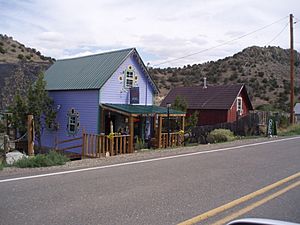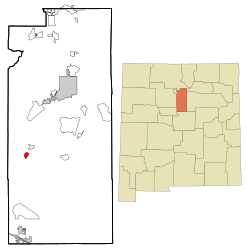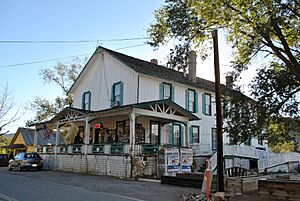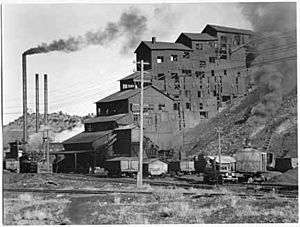Madrid, New Mexico facts for kids
Quick facts for kids
Madrid, New Mexico
|
|
|---|---|

old miners' cabins remodeled into shops
|
|

location of Madrid, New Mexico
|
|
| Country | United States |
| State | New Mexico |
| County | Santa Fe |
| Area | |
| • Total | 1.39 sq mi (3.60 km2) |
| • Land | 1.39 sq mi (3.60 km2) |
| • Water | 0.00 sq mi (0.00 km2) |
| Elevation | 6,122 ft (1,866 m) |
| Population
(2020)
|
|
| • Total | 247 |
| • Density | 177.70/sq mi (68.59/km2) |
| Time zone | UTC-7 (Mountain (MST)) |
| • Summer (DST) | UTC-6 (MDT) |
| ZIP code |
87010
|
| Area code(s) | 505 |
| FIPS code | 35-46100 |
| GNIS feature ID | 2408159 |
Madrid is a small community in Santa Fe County, New Mexico, United States. It's called a census-designated place (CDP), which means it's a special area used for gathering census information. Madrid is part of the larger Santa Fe, New Mexico area.
In 2020, about 247 people lived there. Madrid used to be a busy coal mining town. Today, it's famous for its many art galleries and shops. These line New Mexico State Road 14, also known as the Turquoise Trail. You can still see parts of its past, like the old Mineshaft Tavern and the Coal Mine Museum.
Contents
History of Madrid
Early Days and Coal Mining
People first became interested in the Madrid area in the 1600s because of lead mines. A person named Roque Madrid explored the area. It's not clear if the town's name comes from him or from the capital city of Spain. When people say "Madrid" in New Mexico, they usually put the stress on the first part: MAD-rid.
Coal mining started here around 1835. The coal was found in an area called the Cerrillos Coal Bank. This name came from the nearby mining town of Cerrillos Station.
In 1880, the New Mexico & Southern Pacific Railroad arrived. This railroad was part of the AT&SF company. They bought the coal mining area in 1891. The company then set up the town, mines, and other buildings. They also built a railroad track, about 6.25 miles long, to connect Madrid to the main railroad line.
Building the Town
The railroad track reached a mining camp called Keeseeville in 1892. This is where the town of Madrid was built. The railroad company actually brought in pre-made wooden cabins. These cabins came from places as far away as Topeka, Kansas. This was because there weren't enough builders in the area to quickly create homes for all the miners.
Madrid officially celebrated its founding in 1895. For about 80 years, different companies owned the entire town. This meant Madrid was never officially a city or town on its own.
End of the Coal Era
In the late 1940s, people started using less coal. Natural gas became a popular way to heat homes. Also, the AT&SF railroad began using diesel-powered trains instead of coal-fired steam locomotives.
By 1954, the Albuquerque and Cerrillos Coal Company stopped working. Most of the people who lived in Madrid moved away. The railroad track was removed soon after.
Madrid Miners Baseball Team
The Madrid Employees Club started a semi-pro baseball team called the Miners. This team was very successful and won many championships. The Oscar Huber Ballpark in Madrid was special. In the 1920s, it was the first baseball park west of the Mississippi River to have lights for night games.
Geography of Madrid
Madrid covers a total area of about 1.4 square miles (3.6 square kilometers). All of this area is land.
Environmental Challenges
When coal was mined, waste rock was left behind. These black piles of waste are called "gob piles." They cover the hillsides around Madrid. They also stain the red earth in the arroyo, which is a dry creek bed. This arroyo runs between the old miners' cabins.
These "gob piles" are a part of Madrid's history. They attract tourists and filmmakers, which helps the town. However, they also cause problems for people living there. When it rains, water flows down the hills from these piles. This water can cover roads and driveways. It can also flood backyards, crawlspaces, and basements.
A program called the Abandoned Mine Land (AML) Reclamation Program has helped. They have built barriers to direct the water away from homes. They do this without removing the coal piles, as these are important to the town's history. People in Madrid have different ideas about what else should be done.
Population Information
| Historical population | |||
|---|---|---|---|
| Census | Pop. | %± | |
| 2020 | 247 | — | |
| U.S. Decennial Census | |||
In 2010, there were 204 people living in Madrid. There were 134 households, which means 134 different homes. About 9% of these homes had children under 18 living there. Most households, about 75%, were not families. Many people, about 64%, lived alone.
The average age of people in Madrid in 2010 was about 47.6 years old.
Education in Madrid
Students in Madrid attend schools in the Santa Fe Public Schools district.
Children usually go to Amy Biehl Elementary School. For middle school, they attend Milagro Middle School. Older students go to Santa Fe High School.
Before 2017, students went to Capital High School. The school district later decided to change the boundary.
Famous People from Madrid
- Mae Marsh, an actress
- Daniel Quinn, an author
See also
 In Spanish: Madrid (Nuevo México) para niños
In Spanish: Madrid (Nuevo México) para niños




